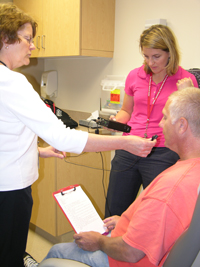 |
Speech therapist Amy Nordness, right, has ALS patient Charles Fowler read sentences to determine his speech abilities as Marsha Sullivan, director of the speech and language disorder department at MMI, holds the microphone at the adult MD clinic held in the south Clarkson Tower last Friday. |
Despite a diagnosis of amyotrophic lateral sclerosis (ALS), better known as Lou Gehrig’s disease, back in December of 2005, Fowler’s strength hasn’t deteriorated as it typically does with ALS. Fuchs, an associate professor in the School of Allied Health Professions, gets a workout resisting Fowler’s force. His power is literally off the charts.
It leads doctors to believe that ALS may be a misdiagnosis, but because of the spasticity in his legs, the stiffness in his joints and the tumbles he takes, the 47-year-old Fowler keeps coming back to the clinics held twice a month for adults with muscular dystrophy in the south Clarkson Tower.
Sponsored by a grant from the Muscular Dystrophy Association, the adult clinics, along with pediatric clinics held twice a month in the 412 building on Saddle Creek Road, are staffed by Munroe-Meyer Institute (MMI) therapists.
Four times a year, patients with one of the more than 43 forms of MD can see a neurologist, physical therapist, occupational therapist and speech therapist at no cost.
“It’s very convenient for them to see all of those people at one time,” said Marsha Sullivan, director of the speech and language disorders department at MMI. “For most people in wheelchairs, it’s not easy to go from individual to individual and appointment to appointment.”
Tina Fowler compares it to shopping at Wal-Mart, which is known for its array of items available under one roof.
“It’s nice to be able to do everything all at once,” she said.
She and her husband — who live in North Bend — have come to clinics every six months since March of 2006.
While his nerve damage hasn’t progressed much, it’s still comforts Fowler to know that he is being monitored by professionals.
|
Fowler, who uses a cane and sometimes a wheelchair to get around, was told he had three to five years to live when he was diagnosed. For someone who raced dirt bikes and jet skis professionally, it was a tough sentence to take. But Fowler has defied the odds so far and plans to continue.
It is encouraging that there are several sub-types of ALS, some of which are rapidly progressing and others that people can live with for 10-15 years.
“With the muscular dystrophy clinic, a large number of the cases we see involve relatively rare conditions,” said Wayne Stuberg, Ph.D., director of the physical therapy department at MMI and co-director of the adult and pediatric MD clinics — the only ones in Nebraska. “Having a team that is knowledgeable about rare conditions helps with our number-one goal of providing the correct medical diagnosis.
“Our second most important goal is to get patients information on any available treatments,” Dr. Stuberg said. “Just because MD is incurable doesn’t mean it’s untreatable.”
Lynne Humphrey, who has a condition called polymyositis, is grateful for those treatments. She sees a physical therapist for exercises, an occupational therapist for help with her daily living skills and a speech therapist for tips on swallowing.
“The physical therapist teaches me about exercises … I can do to keep from deteriorating,” Humphrey said. “The occupational therapist helps me find adaptive things. For example, I have trouble with fine motor skills, like clasps on necklaces or bracelets. They have catalogs that assist you in finding products to help with those things.
“The speech therapist has taught me to eat slower because as my disease progresses, it’s a possibility I may have difficulty swallowing, so I need to train my muscles now to go slower.”
After being diagnosed at the age of 41 five years ago, Humphrey — who was born in Council Bluffs and now lives in Carroll, Iowa — experiences muscle weakness in her upper arms and thighs.
It all started one morning when she woke up and couldn’t walk. Her physician thought it was arthritis. Humphrey began coming to clinics every three months about a year ago, which is why she believes she gets along so well now.
“I do pretty good,” she said, noting that she walks without a walker, scooter or cane.
Good might be an understatement as Humphrey is able to work two jobs, one as the director of food and nutrition services for Kuemper Catholic High School and another as a pharmacy technician. If that weren’t enough, she also volunteers with the Boys Scouts, Habitat for Humanity and the MDA.
“I’m going to be supervising in the cantina at Channel 3 for the telethon on Labor Day,” Humphrey said. “I was 12-years-old the first time I donated to the telethon, and I remember calling in and making a donation of $10, which was a lot of money to me at the time. Every year since then, I’ve called in and made a donation.”
Fowler also has donated to the telethon that allows him and others to attend MDA clinics, borrow from the “loaner” closet and receive grant money to built handicapped accessible ramps.
“Anything I can do to make life easier for others with ALS or MD, I’m all about it,” said Fowler, who wears a red bracelet with the words “Strike Out ALS” imprinted on it. “For people who donate to the MDA, God loves them and I love them.”